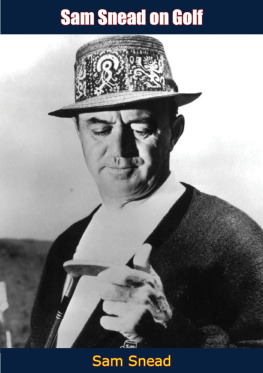Contents
Guide

The author and publisher have provided this e-book to you for your personal use only. You may not make this e-book publicly available in any way. Copyright infringement is against the law. If you believe the copy of this e-book you are reading infringes on the authors copyright, please notify the publisher at: us.macmillanusa.com/piracy.
CONTENTS
To all Weekend Golfers worldwide
ACKNOWLEDGMENTS
Writing this book has been a challenge, a pleasure, and a reward. While it has taken several years to get this book published, I wish to thank Mary Bridges, the illustrator of all the computer-drawn illustrations in this book, for her time, patience, and incredible attention to detail. Mary deserves extra mention because she gave up many lunches and evenings to draw and revise the drawings in this book. Mary and I spent countless hours developing each illustration to the finest detail such that our readers could easily understand the point being described.
I am equally appreciative to Patricia Shea, St. Martins illustrator, who worked with Marys drawings to ensure that they could easily fit into a paperback format. In doing so, we made a series of changes to the drawings so they could be easily displayed and interpreted in a black and white format. Patricia was a pleasure to work with and I especially enjoyed her English accent.
I also wish to thank Marje Cates, an editor and friend, who spent many hours at home and numerous lunches helping to proofread, reason-test, and edit this book. Marje, not being a golfer, proved to be very helpful because she would question passages that did not make sense to her but seemed to make perfect sense to an avid golfer. Her editing has made this book clearer and easier to understand by the reader. From her editing and Marys illustrations, I rewrote many passages and added illustrations to make the book readable by anyone. I can honestly say that this book is a work of art due to the diligence and patience of Mary Bridges, Marje Cates, Patricia Shea, and myself. We spent countless hours working to refine this book.
I owe many thanks to George Wieser, my agent, who believed in me and my book. He never gave up. He had tried the techniques in the book, greatly improved his putting game, and continued, relentlessly in the pursuit of a publisher. He knew it was sellable and that one day it would be published and sold all over the world. He knew that this kind of book could only be written by a golfer who had empathy for the Weekend Golfer, rather than by a golf pro who often does not fully appreciate the problems faced by average golfers. He often raised my spirits when it seemed like no one wanted to publish this unique book on the art of putting. I thank him for his patience, perseverance, and belief that this book would, one day, be published and reach the hands of hundreds of thousands, and perhaps, millions of golfers.
I owe many kind thoughts to Newell Pinch, the golfing friend who was kind enough to write a powerful foreword for this book. He spent many hours reading this book and writing a solid foreword for it, as well as, learning how to apply its techniques.
Finally, I am deeply grateful for the patience and understanding of my wife and family during those long nights and weekends while I was writing and rewriting this book with the help of Mary Bridges, Marje Cates, and Patricia Shea. Thank you.
FOREWORD
Putting should be easy. At least it seems that way. You step up to the ball, look at the hole, and aim in the direction of the hole. Sometimes you will get close. You might even putt it in. More often than not, youll come up short or go past the hole. You will miss 3-foot putts as often as you make them. For some, this kind of putting is okay, but for most Weekend Golfers this inconsistency is not acceptable. They want to play better, so they question their playing partners, friends, or the local golf professional. There is nothing wrong with a little guidance, but often this advice is a one-time thing and is short-lived. New problems may develop.
Once the Weekend Golfer realizes the importance of putting to his game, he or she will seek out ways to improve putting success. The author has developed with this book a solid plan for the Weekend Golfer. Simply by reading a few pages a golfer can make immediate improvements. After reading the entire book, the Weekend Golfer can become a superb putter, finding that elusive key to consistency. There is even a chapter on how to putt from off the green, something that could be useful as an alternative to chipping.
This book presents a well-organized plan for becoming a better putter almost overnight. Many tips are so simple they are often overlooked, even by some of our best putters. The book is concise, well-illustrated, and thorough in its approach.
The most important skills you will learn from this book are: the correct technique for holding a putter, addressing the ball, taking aim, stroking the ball, and sinking the putt. The next step is to STICK WITH IT .
This book is essential reading for any weekend golf enthusiast. I hope you enjoy it as much as I have.

Newell O. Pinch
Former CEOSouthern California Golf Association
Cofounder and past PresidentInternational Association of Golf
Course Administrators
Former memberUSGA Regional Liaison Committee
PREFACE
WHY THIS BOOK?
There are few, if any, good books written exclusively for the average Weekend Golfer, the individual who scores from 90 to 112 on a par-72 course. This book is written with the average golfer in mind, and, more specifically, on the one area of golf, putting, in which the average golfer can play as well as the golf pro and achieve significant score reductions. In putting, there are just a few basics to master and only a small number of possible lies with virtually nothing standing between the ball and the hole. With woods and irons, there are many swing fundamentals to master, hundreds of possible lies, and a variety of potential hazards between the ball and green.
With fewer fundamentals to learn, putting is an area the average golfer should emphasize because he can learn to become an excellent putter in a relatively short period of time. Good putting is the key to good golf thats why putting is the main subject of this book.
Most golfing publications tend to emphasize the use of woods and irons, with putting being treated as a secondary importance. When an entire publication is devoted to putting, its usually written in too much detail for the average golfer. While parts of the publication may be useful, its difficult for the reader to pick and choose which areas will be most helpful.
This book has been designed just for the average golfer. Its a simple and easy-to-read book on putting. It has been written for you, the average Weekend Golfer. You are the individual who plays once per week or once or twice a month and carries a handicap of 18 to 40 on an 18-hole, par-72 course. You enjoy the game, like to score well, but seldom have time to play or practice regularly. You think about golf, watch it on television, and wish you could play more often.
A style of play is introduced that combines the successful techniques used by many golfers today and some from my own personal experiences as an average Weekend Golfer. You dont have to pick and choose. Every point discussed will help you to develop a new putting style, one to rely on and be proud of. The book advances the idea that youll discard your current method of putting and develop a new putting style using the suggestions presented.











